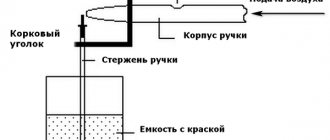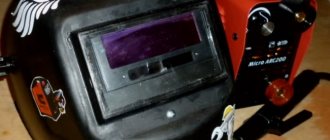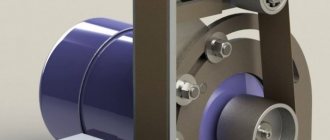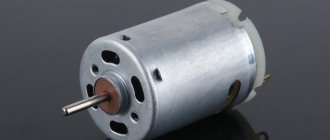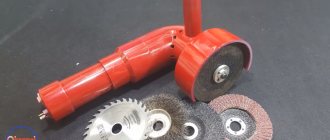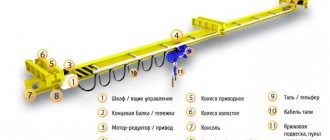Principle of operation.
The basic principle of operation of oscillators can be explained by analyzing the behavior of the oscillating LC circuit of the circuit shown in Figure 1, which uses an inductor L and a previously fully charged capacitor C. The capacitor begins to discharge through the inductor, which is a consequence of the conversion of its electrical energy into an electromagnetic field.
This field can be accumulated by an inductor. This flow of current through the circuit continues until the electromagnetic field collapses, which is the result of the electromagnetic energy being converted back into electrical form, forcing the cycle to repeat itself. Whatever the case, the capacitor is now charged with negative polarity, resulting in an oscillating waveform at the output.
Figure 1 Diagram of an oscillatory LC circuit
However, the oscillations that occur due to the interconversion of two forms of energy cannot last forever, because they are subject to the effect of energy loss due to the resistance of the circuit. As a result, the amplitude of these oscillations constantly decreases, tending to zero. The vibrations simply disappear naturally.
This shows that you need to get oscillations that continue over time and have a constant amplitude, which is needed to compensate for the loss of energy
However, it is important to note that the incoming energy must be precisely controlled and it must be equal to the lost energy to obtain oscillations with constant amplitude
If more energy is supplied than lost, the amplitude of the oscillations will increase (Figure 2a), resulting in a distorted output. If the energy that is supplied is less than that that is lost, the amplitude of the oscillations will decrease (Figure 2b), resulting in insufficient oscillations.
Figure 2 (a) Increasing Oscillations (b) Decaying Oscillations (c) Constant Amplitude Oscillations
In fact, oscillators are nothing more than circuit amplifiers that are produced with positive or restorative feedback, where part of the output signal is feedback to the input (Figure 3). Here, the amplifier contains an active amplification element, which can be a transistor or an operational amplifier, and the common-mode feedback signal is responsible for maintaining the oscillation by terminating losses in the circuit.
Figure 3 Typical oscillator
When the power supply is turned on, the oscillators begin to operate due to the presence of electronic noise. These noise signals cycle, amplify, and converge into a single-frequency sine wave very quickly. The expression for the closed-loop gain of the oscillator shown in Figure 3 is:
Here A is the voltage gain of the amplifier and ß is the gain of the feedback circuit. If Aß > 1, then the oscillations will increase in amplitude (Figure 2a). If Aß < 1, then the oscillations will decay (Figure 2b). If Aß = 1, then the oscillations will have a constant amplitude (Figure 2c).
In other words, this indicates that if the feedback loop gain is small, the oscillations are damped, while if the gain is large, the output result will be distorted. And only if this coefficient is equal to unity, the oscillations will have a constant amplitude, generating an independent cycle of oscillations.
Oscillators are divided into two categories, namely linear or sine oscillators and discharge oscillators. In sinusoidal oscillators, the energy flow always goes from the active elements of the circuit to the passive ones, and the oscillation frequency is determined by feedback.
However, in the case of discharge oscillators, energy is exchanged between the active and passive components, and the frequency of oscillation is determined by the charging and discharging of the stationary elements involved in the process. Sine oscillators produce weakly varying sine waves at the output. Discharge oscillators produce non-sinusoidal waveforms (sawtooth, triangle, or square).
Pulse devices
An oscillator is a device that is divided into two types. A device with pulsed power allows you to provoke its constancy at alternating current at the initial occurrence of an arc. When welding, fluctuations in the current used may occur, which can sometimes cause deterioration in the quality of work. To avoid this, the oscillators are synchronized.
Often, to excite a non-contact arc, pulse-type generators are used, which have accumulated reservoirs that are recharged from a special device. Taking into account the fact that the phase change of the welding current in the working process is not always stable, in order to organize reliable functionality of the generator, a device is required that synchronizes the discharge of the capacitance in cases where the current from the arc passes through zero.
Using alternating current, the oscillator is used for welding with both conventional electrodes and elements used to work with stainless steel, non-ferrous metals, and argon processing.
Conclusion
An oscillator welding device, what it is, was discussed above. In general, we can define it as a device that allows you to create a working arc without the electrode touching the surface of the components being processed. It also provides arc stability.
This functionality of the unit is guaranteed by the fact that the electric current coming from the welding equipment interacts with a similar high frequency and high voltage. Particularly significant assistance from the device in question is observed when working with non-ferrous metal and stainless steel. The big advantage is that the oscillator can be assembled with your own hands, without having superpowers or knowledge of the structure and placement of elements of electrical appliances.
How to make an oscillator device with your own hands
As mentioned above, oscillators allow you to ignite a welding arc without the electrode touching the surface of the parts being connected, and also maintain its stability during the combustion process. This functionality of this device is ensured due to the fact that the electric current coming from the welding machine is superimposed on a current of high frequency and high voltage. A device is used that can be made with your own hands, mainly for welding aluminum parts.
To make a homemade welding oscillator, you can use the simplest and most common circuit. The main element of the circuit of such a device is a transformer, which ensures an increase in the voltage value from the standard 220 to 3000 V. The main difficulty in making an oscillator with your own hands is the spark gap through which a powerful electric spark passes.
Homemade single spark gap
The most important element of the welding oscillator circuit is the oscillatory circuit, which must contain a blocking capacitor. Such a circuit, which also includes a spark gap and an inductor, solves the main task of the oscillator - generating damped high-frequency pulses that facilitate ignition of the welding arc and its maintenance in a stable state.
Both serial and hand-made, such a device can be made according to two main schemes: continuous and pulsed. Oscillators operating in a continuous circuit are considered less efficient; their design requires the use of devices that protect them from increased voltage. More effective are pulse oscillators, which ensure rapid ignition of the welding arc and its stable combustion when operating on alternating current.
Schematic diagram of a welding machine with an oscillator
The main control element of the oscillator is a button, which simultaneously turns on the spark gap and is responsible for supplying shielding gas to the welding area. The high-frequency pulses themselves, which ensure the effective performance of welding work, are generated by a spark gap and a high-voltage transformer. The output elements of such a device are two contacts - positive and negative. The first, supplied from a high-voltage transformer, is connected to the torch of the welding machine, the second - to the parts being welded.
In order to make such a device with your own hands, which greatly simplifies the process of welding parts made of non-ferrous metals and stainless steel, it is enough to have basic knowledge of electrical engineering and the skills of assembling electrical devices.
Of course, you can purchase such a device in a store or at the construction market, but it will cost you a lot. If you are going to use it not constantly, but from time to time, then it makes sense to make it yourself.
Safety
To understand what an oscillator is and what it is needed for, you need to have minimal welding skills. The main differences between the devices under consideration and the principle of their operation are given above. When working with such devices, certain safety precautions must be observed.
It is necessary to constantly monitor the correct connection to the welding circuit and check the contacts for serviceability. In addition, you should work using a protective cover, which must be removed and put on when the device is unplugged. It is also necessary to periodically check the condition of the surface of the spark gap (clean it from carbon deposits with sandpaper).
Principle of operation
The main task of the pulse generating device is to upgrade the incoming voltage, increasing its frequency and V, and reducing its duration to an interval of less than a second. This scheme works as follows:
- A button is pressed on the burner and the electrical circuit starts.
- The rectifier at the input equalizes the current and makes it unidirectional.
- Capacitors accumulate voltage for discharge.
- When current is released, it enters an oscillatory circuit consisting of transformer windings. The value of V also increases there.
- The control circuit directs the release of the impulse.
- At the same time, the gas valve opens.
- The pulse produces a discharge that connects the end of the electrode and the product through the air. To do this, a ground cable must be connected to the latter.
- After the welding current passes through the circuit, the high-frequency pulse stops. The seam is carried out on the previously installed settings of the welding machine.
- When the arc is complete, the oscillator provides argon purging of the torch for another 4 seconds. This cools the tungsten electrode and the final section of the weld.
Exploitation
The process of using the welding machine is not difficult, but requires following the instructions.
- There are no restrictions in terms of environmental conditions - the devices are used outdoors and indoors. But if there are unfavorable climatic conditions outdoors (especially precipitation), it is undesirable to perform work using the equipment.
- Temperature range of application – 10-40 degrees, maximum humidity – up to 98%.
- The atmospheric pressure should be in the region of 85-06 KPsk, deviations are extremely undesirable.
- Operating devices in very dusty rooms is fraught with premature failure. Caustic gas and other vapors are harmful - they destroy metal alloys and insulating windings.
- You can begin to perform work only if there is reliable grounding.
- Always before starting operations, check the correct connection of the device to the circuit and the serviceability of its contacts.
- The oscillator casing must be placed on the device and removed only after disconnecting from the circuit.
- The surface of the spark gap must be kept clean and carbon deposits must be removed in a timely manner. If it appears again, you can treat it using sandpaper.
If desired, the unit can be built independently. For a person with basic skills, the task does not present any particular difficulties.
Operating conditions
An oscillator is a device that requires registration with telecommunications inspection authorities. Other operating conditions include the following requirements and capabilities:
- The unit can be used indoors and outdoors.
- During rain and snow, operating the device outdoors is prohibited.
- The operating temperature ranges from minus ten to plus forty degrees.
- Operation of the device is allowed at atmospheric pressure from 85 to 106 kPa and humidity not higher than 98 percent.
- It is strictly not recommended to use the device in dusty rooms, especially those containing corrosive gases or vapors.
- Before you start working, you need to ensure reliable grounding.
Scheme of work
Diagram of an oscillator for welding aluminum connected in parallel
Oscillator circuit for aluminum welding
Circuit of an oscillator connected in series
Oscillator circuit for aluminum welding connected in series
The secondary voltage in the step-up transformer was charged during the half-cycle until the spark gap broke down. After this, the oscillatory circuit is in a short-circuit state, which helps create damped oscillations that have resonant purity; such oscillations are applied to the arc gap through a capacitor and winding. The blocking capacitor helps prevent another gap from being bridged to the voltage source by its winding. The choke, which is included in the welding circuit, protects the winding insulation from breakdown. The power of such a device can be about 250-250 W. The pulse duration does not exceed tens of microseconds.
Do-it-yourself oscillator for welding
It is worth noting that sequential switching devices in practice turn out to be more effective, since they do not require the installation of a special protection source in the common circuit. During operation of the oscillator, the spark gap crackles slightly. The spark gap is set using an adjusting screw, but this procedure is only possible if the device is disconnected from the network.
Kinds
There are two main types of oscillators that are used in welding. They differ significantly, both in the connection method and in the type of operation, therefore, you need to accurately determine the right choice. It could be:
- Pulse - this type is used for devices that operate on alternating current. The pulse oscillator is connected in parallel to the main welding machine.
- Continuous - this type is used for devices that operate on direct current. A continuous oscillator is connected as a follower to the main welding machine.
It is also worth highlighting the main models of this equipment, which are produced for welding and are often used in industry.
| Parameter | OSP3-2M | OSCV-2 | M-3 | OSPP3-300M |
| Drop voltage, V (all operate on alternating current) | 220 | 65 | 200 | |
| Secondary voltage at idle, V | 6000 | 2300 | 2600 | 6000 |
| Arc current | Constant, variable | Variable | Constant, variable | |
| Type of network connection | Parallel | Consistently | ||
| Device power consumption, kW | 0,045 | 0,08 | 0,14 | – |
| Weight, kg | 6,5 | 16 | 20 | – |
DIY oscillator for aluminum welding
The oscillator circuit for welding aluminum with your own hands should correspond as closely as possible to the factory model. The development of a spark gap is considered one of the most difficult moments, since it is in it that the electric spark passes. It is also necessary to select a blocking capacitor along with an oscillating circuit. There are many creation schemes and the basis for success is to select the right components. Thus, in the end you can get the same pulsed or continuous oscillators. When choosing the second option, the circuit must still have high voltage protection. Pulse is easier to manufacture and more efficient in operation due to its simplicity.
Naturally, safety precautions in this matter should come first, since if the circuit is connected incorrectly or the elements are incorrectly selected, everything can deteriorate and become dangerous to human life and health. The manufacture of these items should only be carried out by a specialist with extensive experience.
Operating conditions and precautions
- Before putting a device into operation, it must be registered and undergo a telecommunications inspection;
- It is allowed to use the oscilloscope both in open and indoor areas;
- You cannot use equipment in open areas during precipitation;
- The operating temperature of the equipment ranges from -10 to +40 degrees Celsius;
- Air humidity should be no more than 98%;
- Do not use in dusty areas, as well as in rooms with caustic gases or vapors;
- It is also prohibited to work without grounding;
- Before use, you should always check that the connection to the device is correct;
- Work should only be carried out in a special casing, which can only be removed when the device is disconnected from the power supply.
How does the unit work?
The oscillator, the operating principle of which is to form a high-frequency transformer to recharge the capacitor and maintain a further specific arc value, consists of the following elements:
- A step-up low-frequency transformer (PT) with a secondary voltage of 2-3 kW.
- Discharger (transfer device).
- Inductive oscillation circuit.
- Working capacity.
- Blocking capacitor.
- Safety winding.
Through the last element, the high-frequency oscillation capacitor touches the arc formation. In it, the power source voltage is not subject to shunting. The inductor, interacting with the operating circuit, acts as a winding insulator in the apparatus against breakdown. The most commonly used are cooking oscillators with a power of 250-300 W. The duration of the pulses is literally a tenth of a second.
How the oscillator works
Such devices may have different assembly options, but they are all designed for the same purpose - to excite a welding arc between the end of the electrode and the surface of the product at a distance of 5 mm, without physical contact with the materials. This is achieved by placing the oscillator between the welding current source and the torch with a tungsten electrode. Instead of the latter, there may be a holder for welding with coated electrodes.
The essence of the process is to upgrade the incoming AC voltage with a frequency of 50 Hz into pulses of high frequency and short duration. They are superimposed on the welding current and actively participate in igniting the arc. The oscillator for welding, in most circuit variants, operates in the following sequence:
- The welder presses the control button on the torch.
- The input rectifier receives voltage from the network with parameters of 220 V and 50 Hz. The device rectifies the current and transfers it to the drive.
- The storage capacity collects the discharge.
- The control scheme guides this process. When the mains voltage reaches 0V, a pulse is released for subsequent generation.
- It enters the primary winding of the transformer, where it is converted into a high-voltage pulse.
- At the same time, the control circuit sends a signal to the gas valve and argon is released.
- A short discharge of current occurs, connecting in the air the voltage from the torch and the product to which the mass from the welding machine is attached. The arc is ignited in the already prepared gas cloud, and welding can begin immediately.
- When a welding current with a force of more than 5 A is turned on in the process, the pulse stops its action. Welding is carried out using the parameters that were set on the machine. If contact is lost, the control circuit sends a second pulse to restart the arc.
- After welding is completed, the oscillator adjusts the time of subsequent purging with shielding gas and completes the entire process.
This is very convenient for welding aluminum or alloy steels, where precision in the start of the weld is required, and mechanical cleaning of marks from touching the electrode leaves unnecessary marks. Making an oscillator with your own hands can be simplified to several units. Then, if the welding breaks, you need to start the non-contact ignition action manually by repeatedly pressing the button on the torch.
Continuous units
Such devices operate synchronously with the power source. The excitation process occurs by applying high voltage and frequency to live parts. This current does not pose a danger to the worker, but is capable of exciting a welding arc without contact between the electrode and the workpiece, and due to the high frequency, sufficient arc combustion is maintained.
Oscillators whose types are connected in series are considered more effective. It does not require activation of a special overvoltage protection system in the source circuit. The coil is connected in series to the arc. During operation, the spark gap emits a quiet crackling sound.
With the unit disconnected from the network, you can use the adjusting screw to adjust the spark gap in the range from 1.5 to 2 millimeters. The installation of such equipment should be trusted to specialists, since unprofessional installation can threaten the health and life of the worker operating the device.
How oscillators work
Some novice traders think that leading indicators are some kind of magical tools that can predict the future direction of the price. But that's not true. Remember: no one and nothing can predict short-term price fluctuations.
Leading indicators, such as: stochastic, CCI, RSI, compare
current price compared to the previous one.
If a stock grew rapidly for three days and slowed down on the fourth, then the oscillators will immediately react to this. In other words, leading indicators do not follow the price itself as much as they follow its dynamics (momentum or momentum, whatever you want to call it). As soon as the dynamics have slowed down, they will immediately indicate this to you, warning you of a possible
change in trend. And there is no magic here. This is the nature of price fluctuations.
What Leading Indicators Show Us
Firstly, this is the momentum strength of the current trend, and secondly, support and resistance levels. Let's take a closer look at how this happens.
The chart below highlights the yellow area, which corresponds to the upward wave of the stock. Below the chart there is an RSI oscillator with a period of 2 (that is, the price of the current candle is compared with only the two previous ones, which makes the indicator very sensitive).
When the candles closed near their highs, indicating strong bullish sentiment among traders, the RSI showed rapid growth. As soon as the candles began to close closer to the center, and then even lower, the indicator immediately shows the rounding of its line, which indicates a slowdown in momentum. An RSI reversal occurs when a bearish candle appears.
Almost all leading indicators have overbought and oversold zones. What do they define? The nature of price fluctuations is such that the price always tends to its average (true) values. If it goes too far up from them, then the oscillators show overbought, and down - oversold. See example:
The chart shows that when a stock is consolidating, that is, fluctuating around its average price, the oscillator does not show overbought or oversold. As soon as there are strong movements up or down, the RSI goes to its boundary values.
Often you will see overbought or oversold conditions reinforced by support or resistance levels on the chart itself. This is intuitive because reversals do not happen on their own. It's all about transferring the trading initiative from buyers to sellers and vice versa.
Trading signals provided by oscillators
The first type of signals is when the oscillator values leave either the overbought or oversold zone. This moment corresponds to a reversal of the short-term trend.
The second type of signals is my favorite. I believe this is the best a leading indicator can offer you. These are convergence and divergence. When you see several decreasing troughs on the chart, and increasing ones on the oscillator, then convergence has occurred. Its result is a price reversal upward. divergence is the opposite. For more information, see the page “Divergence and convergence – the best indicator signals”.
Oscillators and risks
Everyone knows that leading indicators give a lot of false signals during a trend. Look at the example:
To improve your results when using leading indicators, remember these rules:
During an uptrend, only react to buy signals, that is, when the oscillators are in the oversold zone. During a downtrend, pay attention only to sell signals, that is, when the oscillators show an overbought zone.
Conclusion
Oscillators characterize the stock one-sidedly. Price dynamics have several characteristics: trend, momentum, volatility. Leading indicators tend to describe one characteristic and leave out others. This, of course, can be compensated for by using several indicators on the chart. But this approach, for the most part, only leads to the complication of trading, and not to increased performance. The best thing you can do to increase your profitability is to study price dynamics through painstaking analysis of clean charts. Use oscillators in your stock filters and you will see that leading indicators are much better at indicating than at giving trading signals
The trading blog thanks you for your attention. Be successful!
Lagging oscillators in trading
Lagging oscillators are indicators that follow price.
Simply put, the price changes first, and only then the indicator indicates the presence of a trend - you won’t be able to catch the very beginning of the movement, but these indicators will indicate changes in the market with high accuracy. Delayed oscillators include:
- Moving Average or moving average
- Bollinger Bands or Bollinger Bands
- MACD (Moving Average Convergence Divergence) or Moving Average Convergence/Divergence
Moving Average Oscillator or Moving Average
The Moving Average oscillator or moving average is a lagging indicator. MA shows the average price value for a certain period, which is set in the settings, and the longer this period, the longer the indicator line reacts to price changes. All trend movements will be shown with a delay, but, on the other hand, we get a dynamic support and resistance level that can be used to catch the end of pullbacks:
In some cases, the moving average line will take a very long time to react to price changes - by that time the trend impulse may completely end. Another obvious disadvantage of the Moving Average is its poor performance in lateral movements - there will be a lot of false signals.
Oscillator Bollinger Bands or Bollinger Bands
The Bollinger Bands Oscillator or Bollinger Bands is a channel indicator for all occasions.
It is able to work perfectly both during sideways movements and during trend price movements. You just need to correctly understand the operation of this indicator. But the indicator is also a lagging oscillator, which means that you will receive some signals with a delay. In sideways movement everything is quite simple and you need to pay attention to the boundaries of the price channel:
- If the price has broken through the upper border, but the lower border has not begun to expand, then we should expect a rollback. Similarly with breaking the lower border
If a trend has begun, then the price reaches the boundaries of the Bollinger Bands, and the opposite boundary begins to expand - this is the action that occurs with a delay, because the price needs time to reach the border of the price channel:
The trend impulse ends when the opposite boundary of Bollinger years begins to narrow, but this does not mean the end of the trend - just the strength of the movement has decreased and it may take time (a pullback) for the price to continue moving in the same direction. During trend movements, the Bollinger Bands middle line can act as a support and resistance level - this is a regular Moving Average indicator, so there is nothing surprising about it:
Oscillator MACD (Moving Average Convergence Divergence) or Moving Average Convergence/Divergence
The MACD (Moving Average Convergence Divergence) oscillator or Moving Average Convergence/Divergence is an indicator that is most often used to find divergence and price convergence (the discrepancy between the indicator readings and what is on the price chart).
MACD consists of a histogram, which is used to determine divergences and convergences, as well as a signal line, which is needed to determine trends and entry points into them. If we consider MACD (or makdi in common parlance) as a tool for searching for divergence, then everything is simple:
The graph goes up, and the indicator histogram gradually decreases - this is a sign of an imminent price reversal. The only problem is that we don’t know exactly when this reversal will happen and how long the divergence will last. Therefore, MACD is a lagging oscillator.
With MACD trends and reversals, everything is also simple:
- The signal line enters the histogram – a trend impulse has begun
- The signal line has gone beyond the histogram - a rollback or price reversal
Of course, entry points in the direction of the trending price movement will be better than against the trend. Don't forget that the MACD oscillator follows the price - it lags in its readings!
Oscillator calculation
The Awesome oscillator (AO) is calculated quite simply and is nothing more than the difference between two simple moving averages (SMA) with periods of 5 (fast) and 34 (slow):
AO = SMA(5) – SMA(34)
What is its difference from MACD, since it is calculated using the same formula? The only fundamental difference is that in the calculation of fast and slow moving averages, the median price is used (the arithmetic mean of the maximum and minimum values of the candle):
MEDIAN PRICE = (HIGH + LOW)/2
Well, perhaps, another difference is that in Awesome oscillator the periods of moving averages are fixed (5 and 34) and do not require settings. While in MACD you can experiment by setting these periods differently depending on the properties of the financial instrument being traded.
DIY oscillator
Despite the fact that welding oscillators of various models are offered on the market, you may need to build such a machine yourself. The implementation of such an idea is quite realistic; making this device with your own hands is not the easiest task, but it is also not a Newton binary.
First, make sure that you really need a DIY welding oscillator and that it is cost-effective.
Oscillator connection diagram.
Here are some factors that will help you with this:
- You are going to cook stainless steel, aluminum or non-ferrous metals.
- You are using DC or AC voltage.
- The current power does not exceed 250 W.
- The secondary voltage received must be equal to or greater than 2500 V.
If you have a welding converter, the work will be much easier: your permanently operating machine will be connected to the welding network in series, which is much simpler. In addition, the arc will behave much better.
It will burn steadily and can be ignited without contact with the surface to be welded, regardless of the current strength.
The current characteristics required in the second winding will help you select the optimal transformer. The inductor should be double - it’s more reliable. If you have two oscillating circuits connected in series, the current and voltage will be stable.
Electrical diagram of the device.
The oscillatory circuits must be identical and must consist of the following components:
- capacitor;
- voltage varistor;
- inductors made of ferrite rod.
The arrester requires a special rigid board, since when triggered the temperature must drop. Tungsten electrodes must be at least 2 mm in diameter, they must be placed strictly parallel, for this they are trimmed. The width of the gap between them is adjusted with a screw.
We connect the first cascade to the inverter terminals, and the second cascade to the welding torch and the workpiece being welded. For high stability of operation, a coil with separate power supply from the battery must be connected to the secondary winding of the second stage.
A mandatory requirement is that the housing must be resistant to moisture, and with special holes for ventilation.
Where to buy?
An oscillator is a device that can be bought in specialized stores or made with your own hands. Making it yourself requires knowledge of connecting electrical circuits and the correct selection of components, the main one of which is a high-voltage transformer.
You can make a homemade model using the simplest scheme. The kit includes a voltage-regulating transformer (from 220 to 3,000 V) and a spark gap that can withstand the passage of a powerful electric spark.
The device is controlled using a button that simultaneously activates the spark gap and the supply of shielding gas to the welding area. The high-frequency pulses that ensure the efficiency of the process are directly generated by a spark gap and a high-voltage transformer. At the output, such a device has positive and negative contacts. The first supplies currents from the transformer and is connected to the torch of the welding unit, the second - directly to the elements being processed.
Lagging Indicators
These indicators are not at all worse than leading indicators. This is simply the principle of their work. They draw price changes more slowly but, due to this, better reflect the emergence of a stable new trend.
These indicators traditionally belong to the trend class. However, some of them can also be used in lateral movements. For example, narrowing Bollinger Bands means reducing price volatility ahead of the subsequent trend.
This can be used both in BO (exploit the low volatility zone) and in Forex - entering along the trend after a “breakout” these are the zones:
Here is the same channel on the left, but in more detail, on a 1-hour time frame. You can immediately see what opportunities this gives:
Pros and cons of oscillators
Oscillators have their pros and cons that you need to know about:
- Oscillators show the situation on the market quite accurately: they determine the beginning of a new trend and reversal points. Some oscillators work great in sideways movements, and some are designed to be profitable during a trend. There are also those who feel great in any market.
- Oscillators are very easy to use - their operation is clear and does not raise serious questions. It is also worth noting the fact that these indicators are leading (or lagging, depending on the nature of their work) and allow you to predict price movements in advance, albeit not always.
- Oscillators are great for determining the strength of a trend, or more precisely, for determining the decrease in this strength. Convergence and divergence perfectly indicate a weakening trend, which means that you can prepare in advance for a price reversal.
- Oscillators are very common - they are available in almost any trading terminal. There are a lot of strategies built on oscillators, as well as thousands of modifications that allow you to use these indicators in various situations.
The disadvantages of oscillators can be safely attributed to the quality of their signals.
There are indicators whose signals need to be filtered constantly. Many oscillators perform very poorly in trending price movements, which poses particular challenges. It is also worth noting the moments when a sideways movement transitions into a trend - at these moments the oscillators will also produce false signals, because they will recommend trading a pullback rather than an emerging trend. It is best to use oscillators in conjunction with other indicators or support and resistance levels. This will help get rid of a number of problems associated with false signals. Also, combinations of Japanese candlestick models with oscillators perform very well - some find imbalances in the market, while others indicate the exact entry point.
Another disadvantage of oscillators is the lack of ideal settings. Yes, there are standard (recommended) settings, but for the indicator to work better, it very often needs to be reconfigured to suit the current situation. This process allows you to weed out some of the false signals in some cases, but also increase their number in other situations. Also, changing the oscillator settings can lead to its “sensitivity” - some profitable signals may pass by.
Circuits for the oscillator
The connection method and types of equipment components depend on which device the unit will be used in combination with.
Control with plasma cutter
To produce plasma in the cutter, a voltage of 20,000 V is required. Therefore, the design of the device is supplemented with a spark oscillator.
The following components must be displayed on the drawing of the auxiliary device:
- Start button (S3). Turns on the plasma cutter power supply, providing electricity to the oscillator circuit.
- Capacitor (C5). The duration of the issued pulse depends on this detail.
- Thyristors (T7, T8). After they are closed, the power supply to the oscillator is suspended and the arc becomes stable.
In combination with argon arc welding
In this case, it is recommended to assemble a continuous oscillator. It is connected to the electrical network through a transformer. Assembling the circuit does not require expensive parts or complex steps. Difficulties can arise only at the stage of installing thyristors. They are selected empirically, assessing the stability of the arc.
Simpler oscillator drawings that do not include thyristors are also used. You can assemble a device according to such a drawing with minimal knowledge of electrical engineering.
For inverter device
The oscillator for the inverter is installed between the electrode holder and the rectifier.
The block diagram includes the following components:
- voltage rectifier;
- capacitor charging means;
- power unit;
- impulse generating module;
- manager;
- gas inlet valve;
- step-up transformer;
- voltmeter.
For working with aluminum
When welding this metal, special conditions are observed. In this case, it is difficult to obtain and maintain a powerful arc. Therefore, the welding machine is supplemented with an oscillator, which converts low-frequency alternating current into high-frequency current. The component is introduced into the circuit parallel to or after the inverter.
Peculiarities
In order to independently produce this equipment, which greatly facilitates the welding of parts made of non-ferrous metals and stainless steel, it is enough to have minimal knowledge of electrical engineering and skills in assembling electrical devices.
The main thing to consider when assembling and using a homemade oscillator is strict adherence to safety precautions when operating electrical appliances. It is important to adhere to the correct assembly of electrical circuits, and also to use only those elements that have optimal characteristics.
What are oscillators in Forex?
In technical analysis, Forex oscillators are indicators of the speed of price movement over a specific period of time. They refer to a leading indicator that can move around the zero line in the range from 0 to 100%. During those periods of time when the price is stable, it either moves only within the channel, or pauses briefly in order to reverse. The oscillator in the Forex market is precisely designed to find points after which the price will move either along the trend or to the reverse border of the channel.
The main concepts that are needed when using oscillators are the concepts of oversold and overbought. This is the name for situations in which the indicator value reaches the upper or lower limit of the scale:
- The concept of overbought is used when it is said that the price is within the upper limit, and the probability of its increase is extremely small.
- The concept of oversold, on the contrary, is used in situations where the price is near the lower limit, and its further fall is unlikely.
Practical application of oscillators
Using oscillators in combination with other indicators and technical analysis techniques is a very powerful tool for identifying trade entry and exit points.
In technical analysis, oscillators are better suited to sideways markets and work more effectively when they are used in combination with indicators that determine whether the market is trending or in a sideways range.
Moving average can be used to determine the state of the market. As soon as the indicator gives a signal that the market has moved sideways, the trading strategy changes and oscillator signals begin to be used to make trading decisions.
Not all oscillators will give the same signals on the selected instruments, but by constantly experimenting with different indicators and financial assets, you can build a reliable strategy that will provide stable profits.

